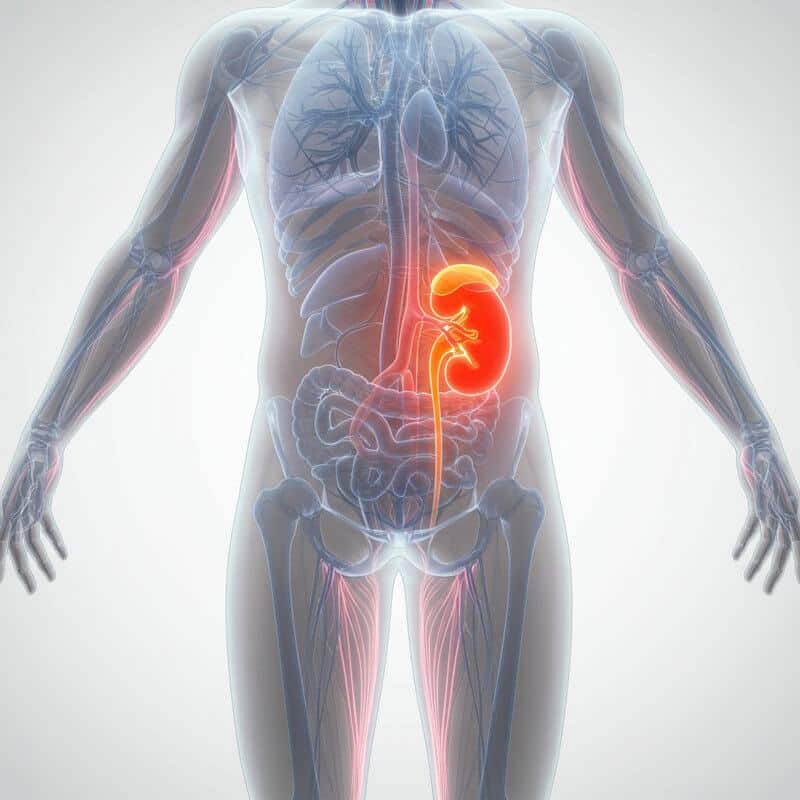28 Surprising Uses for Apple Cider Vinegar
Apple cider vinegar (ACV) has surged in global popularity, with market research indicating a projected value of $1.3 billion by 2025 (Grand View Research). Celebrated for its versatility, ACV is incorporated into routines worldwide, especially for its reported positive effects on digestive and metabolic systems (NCBI). However, a challenge persists in separating anecdotal uses from evidence-based advantages, as not all claims are supported by robust scientific research. This article explores the many surprising applications of ACV, highlighting both tradition and science.
1. Natural Food Preservative

Apple cider vinegar’s effectiveness as a natural food preservative stems from its high acetic acid content, which creates an environment hostile to many bacteria and fungi. This antimicrobial property is well-documented; acetic acid has been shown to inhibit common foodborne pathogens like Escherichia coli and Salmonella (NCBI Study). The principle behind using ACV in preservation mirrors traditional pickling, where vinegar solutions have long been used to extend the shelf life of vegetables and fruits by lowering pH and preventing microbial growth.
To preserve fresh produce at home, simply immerse cleaned fruits or vegetables in a mixture of ACV and water (commonly in a 1:1 or 1:2 ratio, depending on taste preference), optionally adding salt, herbs, or spices. Store the mixture in sterilized glass jars in the refrigerator for optimal safety and flavor. This method not only keeps produce fresh for longer periods but also imparts a pleasant tang and enhances the nutritional profile with beneficial compounds from the vinegar itself (Healthline). As a safe, chemical-free alternative to store-bought preservatives, ACV offers both tradition and modern practicality in the kitchen.
2. Salad Dressing Base

Apple cider vinegar is prized in culinary circles for its ability to emulsify oils and enhance the flavors of fresh greens and vegetables, making it an excellent base for salad dressings. The natural acidity of ACV not only brings a bright, tangy note to dressings but also helps to blend oil and water-based ingredients, resulting in a smooth, cohesive vinaigrette. Compared to balsamic or red wine vinegar, ACV offers a milder, fruitier profile with subtle apple undertones, making it versatile for a wide range of salads and cold dishes (Bon Appétit).
To make a simple homemade vinaigrette, combine three parts olive oil with one part apple cider vinegar, a teaspoon of mustard (for added emulsification), a pinch of salt, and freshly ground black pepper. Whisk or shake vigorously until the mixture is well blended. For extra flavor, consider adding honey, minced garlic, or fresh herbs. This easy dressing not only elevates salads but can also be drizzled over roasted vegetables or used as a marinade. With its unique balance of tang and sweetness, ACV stands as a healthy and flavorful alternative in the world of dressings (EatingWell).
3. Blood Sugar Regulation
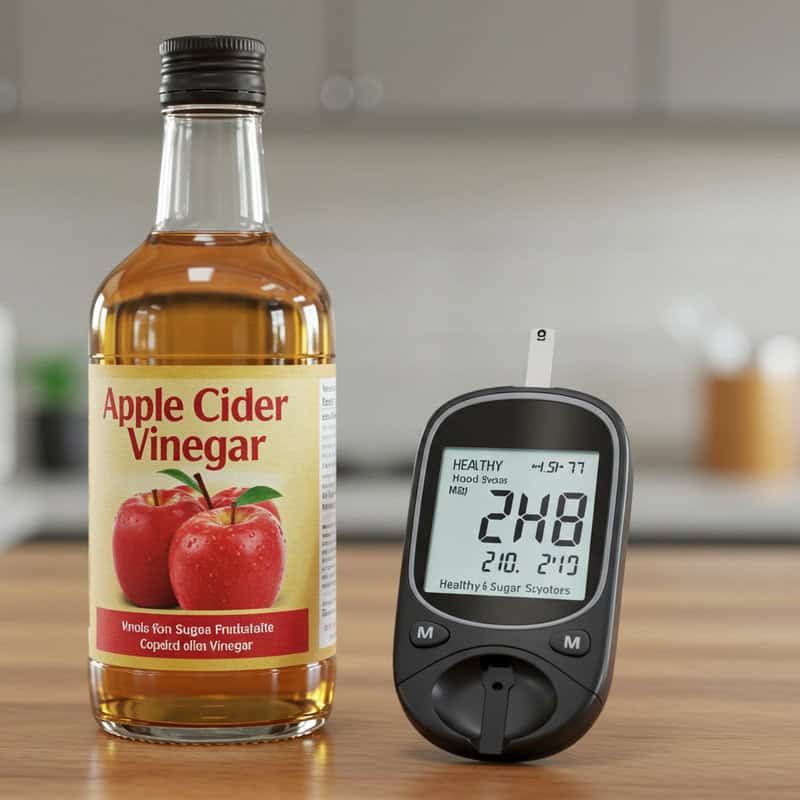
Apple cider vinegar has garnered attention for its potential to help regulate blood sugar levels, particularly by improving insulin sensitivity. A 2022 U.S. study published in the journal Nutrients found that consuming ACV before meals significantly reduced postprandial blood glucose and improved insulin response in adults with insulin resistance (Nutrients, 2022). The acetic acid in ACV appears to slow the digestion of carbohydrates, thereby preventing rapid spikes in blood sugar after eating.
To potentially harness these glycemic benefits, many experts suggest incorporating one to two tablespoons of ACV diluted in a large glass of water, consumed just before or with meals. It can also be used as a component in salad dressings or marinades to integrate seamlessly into your diet. However, it’s essential to note that while these effects are promising, ACV should not replace prescribed diabetes medications or medical advice. Consulting a healthcare provider before adding regular ACV consumption to your routine is crucial, especially for those with diabetes or other metabolic conditions (American Diabetes Association).
4. Sore Throat Soother

Apple cider vinegar has long been hailed in folk medicine as a natural remedy for soothing sore throats, largely due to its antibacterial properties. The acetic acid found in ACV can help create an inhospitable environment for bacteria, potentially reducing the severity or duration of throat discomfort (NCBI). While scientific evidence specifically examining ACV’s effectiveness on sore throats is limited, its use as an antimicrobial agent is well-documented in broader research.
A traditional approach involves mixing one to two tablespoons of apple cider vinegar with a cup of warm water, creating a diluted solution for gargling. This method is believed to help cleanse the throat and may provide temporary relief from irritation (Healthline). However, overuse or undiluted application can be harmful, as the acidity of vinegar may erode tooth enamel and irritate sensitive throat tissues. It’s important to limit gargling to once or twice daily and to rinse the mouth with plain water afterward. Those with chronic sore throats or underlying health conditions should consult a healthcare provider before using ACV as a remedy.
5. Dandruff Remedy
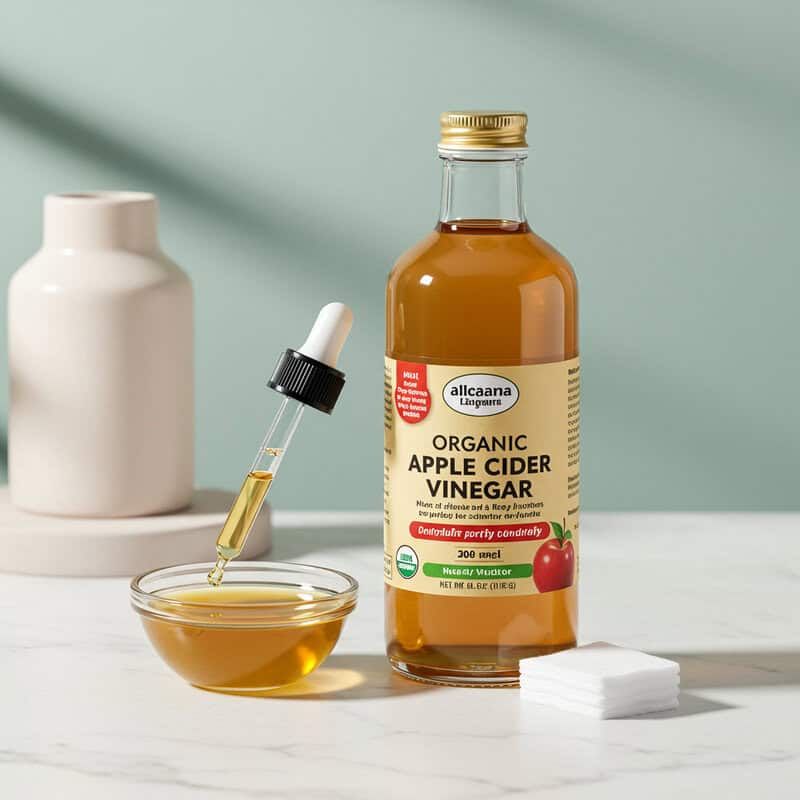
Apple cider vinegar is often touted as a natural solution for dandruff due to its acidic nature, which helps restore the scalp’s natural pH balance. By lowering the scalp’s pH, ACV may inhibit the growth of Malassezia fungus—a common contributor to dandruff—and reduce itchiness and flaking. This natural approach contrasts with commercial anti-dandruff shampoos, which typically rely on medicated ingredients like zinc pyrithione or ketoconazole (Healthline).
To use ACV as a scalp rinse, dilute one to two tablespoons of apple cider vinegar in one cup of water. After shampooing, pour the diluted mixture onto your scalp, gently massaging it in for a few minutes. Allow it to sit for five to ten minutes before rinsing thoroughly with water. This method can be repeated once or twice a week. It’s essential to use ACV in moderation and never apply it undiluted, as its acidity could cause scalp irritation or dryness. If irritation persists or worsens, discontinue use and consult a dermatologist (Medical News Today).
6. Natural Household Cleaner
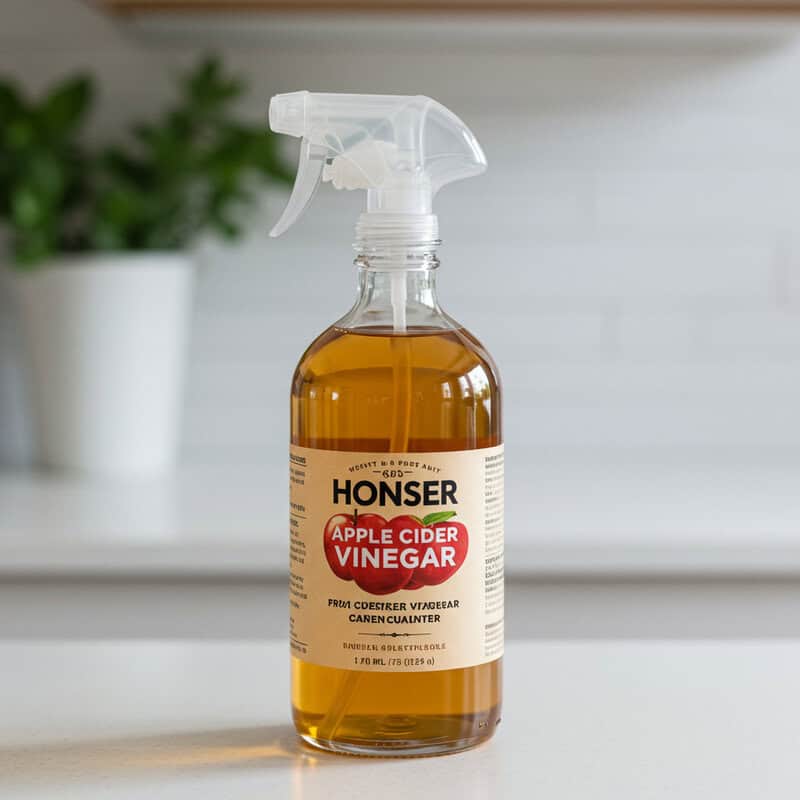
Apple cider vinegar serves as an effective natural household cleaner thanks to its acetic acid content, which has proven antimicrobial properties against common bacteria and some viruses (NCBI). Unlike many chemical cleaners that may contain harsh or potentially toxic ingredients, ACV offers a more environmentally friendly and safer alternative for everyday cleaning tasks. While it may not disinfect as powerfully as products containing bleach or ammonia, ACV is well-suited for routine cleaning, deodorizing, and removing light stains or mineral deposits on various surfaces.
To create a basic ACV cleaning solution, mix one part apple cider vinegar with one part water in a spray bottle. This versatile mixture can be used to clean countertops, glass, sinks, and even some appliances. For added fragrance and antimicrobial boost, consider adding a few drops of essential oils such as lemon or tea tree oil. Spray the solution onto surfaces and wipe clean with a soft cloth or sponge. Avoid using ACV on natural stone surfaces like granite or marble, as its acidity can damage these materials. For more comprehensive cleaning tips, see resources from Good Housekeeping.
7. Fruit and Vegetable Wash

Apple cider vinegar is increasingly used as a natural wash for fruits and vegetables, valued for its ability to help remove surface pesticide residues and reduce microbial contamination. Studies have confirmed ACV’s acetic acid content can significantly decrease the presence of certain bacteria and pathogens on produce, offering more protection than a simple water rinse (NCBI). While water alone can remove dirt and some residues, ACV’s antimicrobial properties create an added layer of defense against contaminants such as E. coli and Salmonella.
To use ACV as a produce wash, fill a large bowl with four cups of water and add a quarter cup of apple cider vinegar. Place your fruits and vegetables in the mixture, let them soak for 5-10 minutes, and gently scrub with your hands or a soft brush. Rinse thoroughly with clean water afterward to remove any lingering vinegar taste or odor. This simple method is suitable for most produce, though it’s not recommended for porous or delicate items like berries, which may absorb too much vinegar. For more tips on safe produce washing, visit FDA.
8. Skin Toner

Apple cider vinegar is a popular DIY skin toner due to its natural astringent properties and its potential to help balance the skin’s pH. The acetic acid in ACV can tighten skin and reduce the appearance of pores, while its slightly acidic pH may help restore the skin’s barrier function, especially for those with oily or acne-prone complexions (Healthline). Unlike many commercial toners, which may contain alcohol, synthetic fragrances, or harsh chemicals, ACV offers a minimalist and cost-effective alternative that some individuals find effective for everyday skincare routines.
To use apple cider vinegar as a toner, dilute it with water—typically one part ACV to three or four parts water—to reduce the risk of irritation. After cleansing your face, apply the diluted mixture to a cotton pad and gently swipe across your skin, avoiding the eye area. Allow it to dry before applying moisturizer. It’s important to patch-test the solution on a small area first, as undiluted or overly strong mixtures can cause burns or irritation, especially for those with sensitive skin. For more guidance on safe skincare practices, refer to the American Academy of Dermatology.
9. Itch Relief for Bug Bites
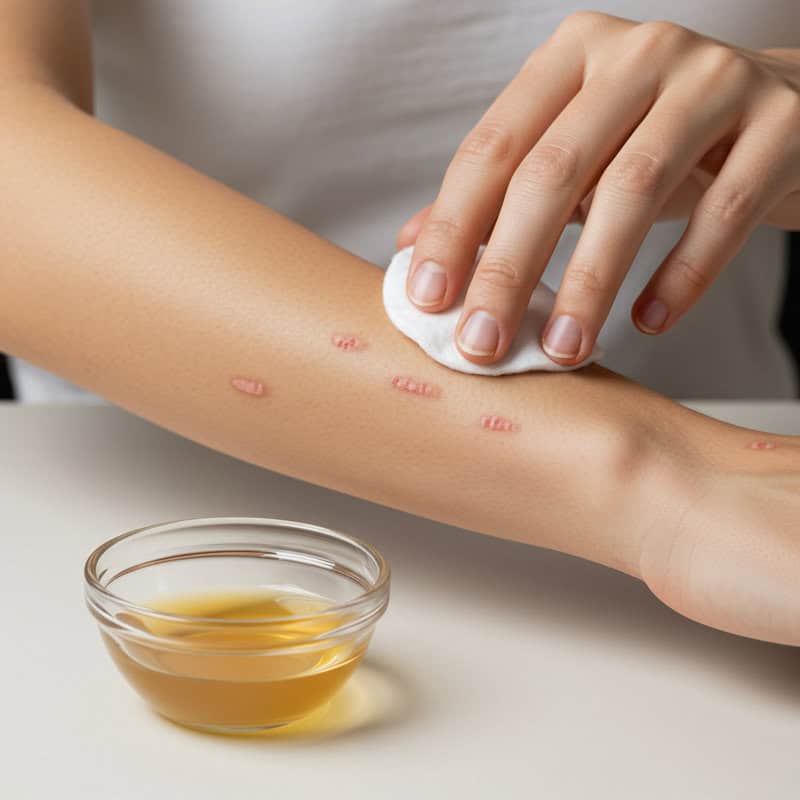
Apple cider vinegar has been used as a home remedy for soothing the itch and irritation caused by bug bites, thanks to its mild anti-inflammatory properties and the calming effect of its acetic acid content. ACV may help neutralize the skin’s pH in the affected area and reduce swelling, providing temporary relief from itching and discomfort (Healthline). While over-the-counter creams often contain corticosteroids or antihistamines to combat inflammation and itching, ACV offers a natural, accessible option for those seeking a chemical-free alternative.
For safe spot treatment, dilute apple cider vinegar with an equal part of water to avoid skin irritation. Dip a clean cotton ball or pad into the solution and gently dab it onto the affected bug bite area, allowing it to air dry. This can be repeated up to two times daily as needed. Always avoid using undiluted ACV, especially on broken skin, as this can cause stinging or burns. If irritation develops or symptoms worsen, discontinue use and opt for a proven medical remedy. For additional information about treating bug bites safely, consult the American Academy of Dermatology.
10. Weight Management Aid

Apple cider vinegar has gained recognition as a potential aid for weight management, primarily due to its ability to promote feelings of fullness and reduce overall calorie intake. The acetic acid in ACV is believed to slow gastric emptying and influence appetite-regulating hormones, which can help curb hunger and support weight loss efforts. A 2021 Japanese study published in the journal Bioscience, Biotechnology, and Biochemistry found that daily consumption of apple cider vinegar contributed to modest reductions in body weight, body mass index, and waist circumference among overweight adults over a 12-week period (PubMed).
To incorporate ACV into a weight management plan, it is recommended to use one to two tablespoons diluted in at least one cup of water, consumed before meals. This approach may help promote satiety and prevent overeating. However, it’s important to remember that ACV is not a magic solution; sustainable weight management requires a balanced diet and regular physical activity. Individuals should also be mindful of potential gastrointestinal discomfort and consult with a healthcare provider before adopting ACV as a daily supplement, especially if they have existing digestive or metabolic conditions.
11. Deodorizer

Apple cider vinegar is a natural deodorizer, valued for its ability to neutralize unpleasant odors rather than simply masking them. The acetic acid in ACV breaks down volatile compounds responsible for bad smells, making it an effective and eco-friendly alternative to synthetic air fresheners, which often contain chemicals and artificial fragrances (Healthline). Unlike commercial products that may only provide temporary scent coverage, ACV actually targets the source of the odor, leaving spaces feeling fresher.
To deodorize shoes, lightly spritz the insides with a mixture of equal parts apple cider vinegar and water. Allow the shoes to air dry completely before wearing. For room freshening, fill a small bowl with ACV and place it in the affected area, or use the diluted spray on fabric surfaces like curtains or upholstery. ACV’s odor-neutralizing effect is particularly useful for kitchens, bathrooms, and gym bags. Always ensure good ventilation and avoid over-saturating fabrics or materials that could be sensitive to acidity. For additional non-toxic cleaning and deodorizing ideas, explore resources from Reader’s Digest.
12. Sore Muscle Relief
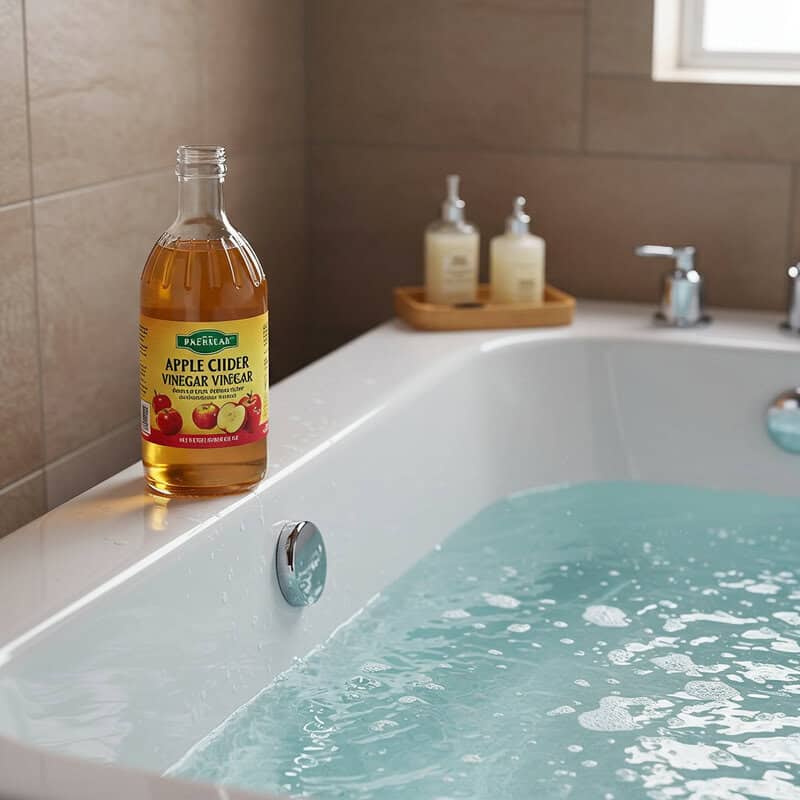
Apple cider vinegar is a popular ingredient in home remedies for relieving sore muscles, particularly after intense exercise. Adding ACV to a warm bath is believed to help ease muscle stiffness and discomfort due to its acetic acid content, which may have mild anti-inflammatory effects (Healthline). While scientific evidence supporting ACV’s direct impact on muscle recovery is limited, many people find the practice soothing and revitalizing, similar to the use of Epsom salts, which provide magnesium sulfate to relax muscles and reduce pain.
To use ACV for sore muscle relief, add one to two cups of apple cider vinegar to a bathtub filled with warm water. Soak for 20 to 30 minutes, allowing the solution to contact sore areas. The acidity of ACV may help soften the skin and refresh the body, but unlike Epsom salts, it does not deliver minerals to the muscles. Always rinse off with fresh water after bathing to minimize skin irritation and avoid soaking if you have open wounds or sensitive skin. For more information about safe soaking practices and alternative remedies, consult the Medical News Today guide on home soaks.
13. Mouthwash Alternative

Apple cider vinegar is sometimes used as a natural alternative to commercial mouthwashes, thanks to its antimicrobial effects that can help reduce harmful bacteria in the mouth. The acetic acid in ACV has demonstrated the ability to inhibit the growth of oral pathogens, which may contribute to improved oral hygiene and fresher breath (NCBI). Unlike many commercial mouthwashes that contain alcohol and artificial flavors, ACV offers a chemical-free option for those seeking a more natural approach to oral care.
To use ACV as a mouthwash, dilute one tablespoon of apple cider vinegar in one cup of water and swish the solution in your mouth for about 30 seconds before spitting it out. It is crucial to avoid swallowing and never use undiluted ACV, as its high acidity can erode tooth enamel and irritate sensitive oral tissues over time. Rinse your mouth thoroughly with plain water afterward to minimize the risk of enamel damage. For individuals with existing dental issues or sensitive teeth, consulting a dentist before starting any vinegar-based oral regimen is highly recommended. For more oral care tips, visit the American Dental Association.
14. Sunburn Soother
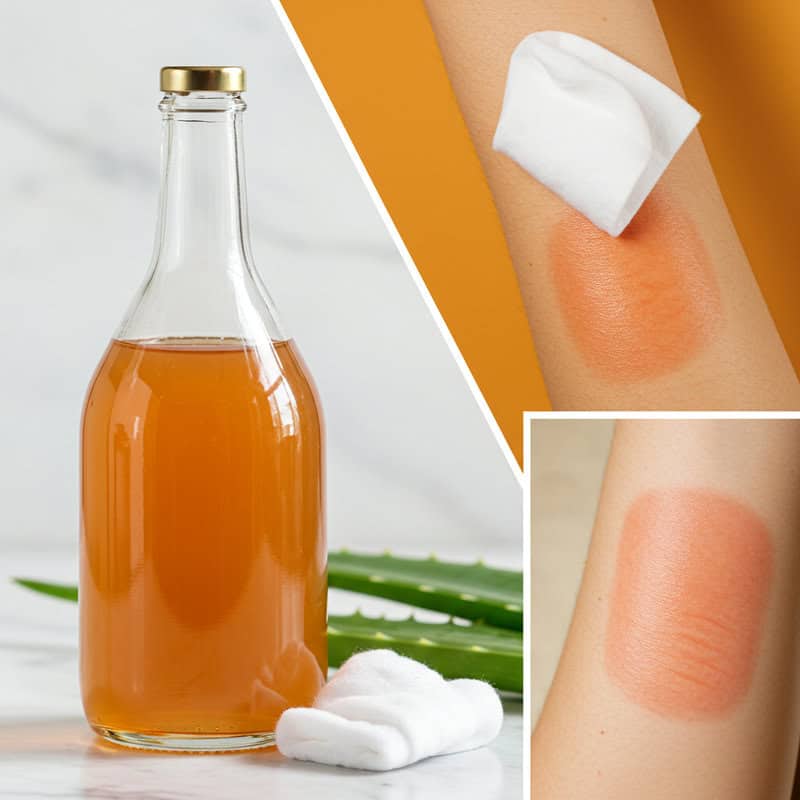
Apple cider vinegar is often recommended in home remedies as a topical treatment for sunburn thanks to its cooling sensation and mild anti-inflammatory properties. The acetic acid found in ACV can help balance the pH of sunburned skin and provide temporary relief from heat and itching (Healthline). While aloe vera gel remains the gold standard for natural sunburn care due to its strong hydrating and anti-inflammatory effects, ACV serves as an alternative cooling agent that is easily accessible in most households.
To use ACV for sunburn relief, dilute one cup of apple cider vinegar in a bathtub of cool water or mix one part ACV with four parts water, then gently dab the solution onto the affected areas with a soft cloth or cotton pad. Avoid using undiluted vinegar, as its acidity can aggravate already sensitive, damaged skin. Do not apply to open blisters or severe burns. After treatment, follow up with a gentle moisturizer to lock in hydration. If sunburn is extensive or blistering, seek advice from a healthcare provider. For more sunburn care techniques, see the American Academy of Dermatology.
15. Foot Odor Control
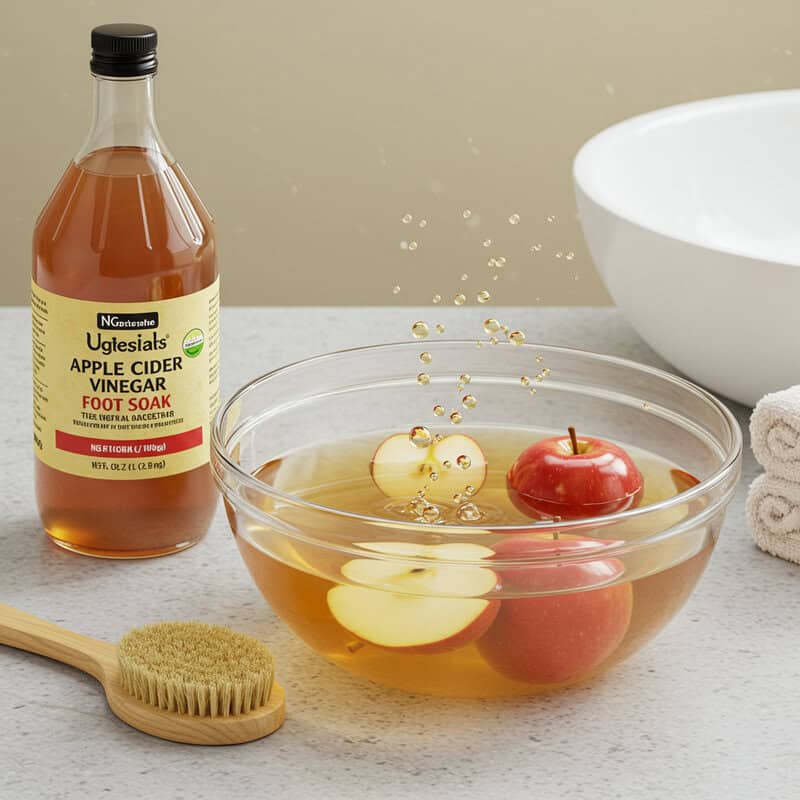
Apple cider vinegar offers a natural solution for controlling foot odor, a problem often caused by bacteria and fungi thriving in warm, moist environments. The acetic acid in ACV possesses antifungal and antibacterial properties that can help inhibit the growth of odor-causing microbes on the feet (Healthline). While commercial foot powders typically work by absorbing moisture and masking smells, ACV targets the root cause by altering the skin’s pH and creating a less hospitable environment for microbes.
To use ACV for foot odor control, mix one part apple cider vinegar with two parts warm water in a basin. Soak your feet for 10 to 20 minutes, then dry them thoroughly with a clean towel. This soak can be done several times a week to help reduce persistent odor and maintain foot hygiene. For added benefit, ensure shoes and socks are also clean and dry. Avoid using ACV soaks on cracked or broken skin, as the acidity may cause irritation. For additional guidance on foot care and odor prevention, refer to the American Podiatric Medical Association.
16. Relieving Hiccups
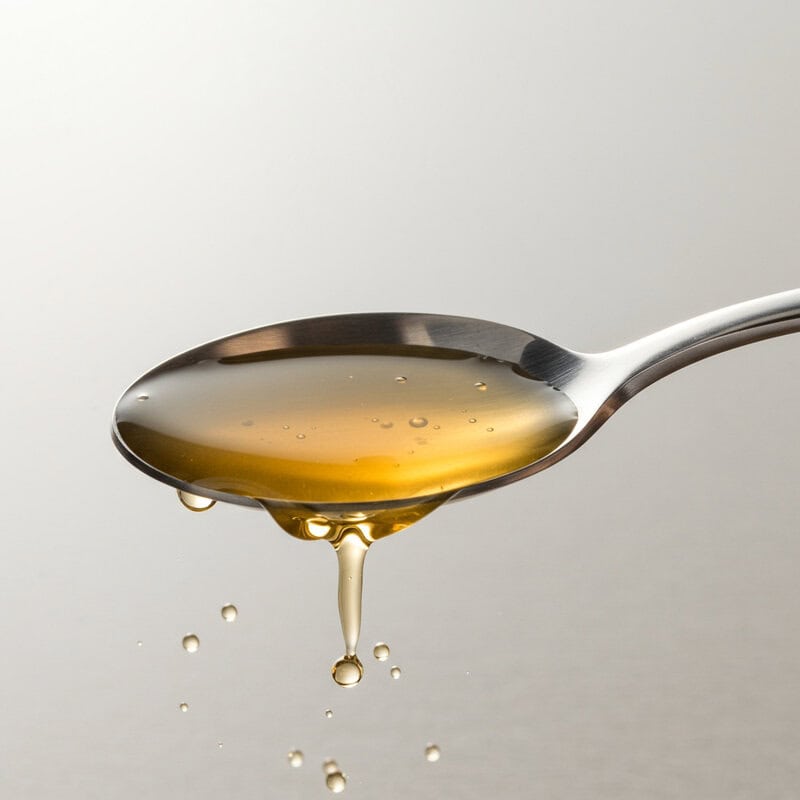
Apple cider vinegar has gained a reputation in anecdotal circles as a remedy for hiccups, with users claiming that its sharp, sour taste can stimulate the vagus nerve and interrupt the hiccup reflex. The vagus nerve plays a key role in controlling the diaphragm, and strong sensory stimuli—such as swallowing a spoonful of diluted ACV—may help reset its signaling and stop hiccups. While this approach lacks robust scientific validation, it is considered a harmless experiment for those seeking fast relief (WebMD).
Compared to other home remedies—such as holding your breath, drinking water upside down, or swallowing a teaspoon of sugar—ACV’s mechanism is similar in that it provides a sudden sensory stimulus. To try this method, dilute one teaspoon of apple cider vinegar in a small glass of water and sip slowly. This can be repeated once or twice if the hiccups persist. However, if hiccups are frequent, prolonged, or associated with underlying health concerns, it’s best to consult a healthcare provider. For more information on hiccup remedies and when to seek medical attention, visit the Mayo Clinic.
17. Cleaning Coffee Makers

Apple cider vinegar is an effective and natural solution for cleaning coffee makers, particularly for dissolving mineral deposits and limescale that accumulate with regular use. The acetic acid in ACV breaks down these mineral buildups, helping to restore brewing efficiency and preserve the appliance’s lifespan. While white vinegar is a more common choice for descaling due to its neutral scent and color, ACV offers similar cleaning power with the added benefit of a subtle apple aroma (Good Housekeeping).
To descale a coffee maker using apple cider vinegar, fill the water reservoir with a mixture of equal parts ACV and water. Start a brew cycle without coffee grounds and allow the solution to run halfway before pausing for about 30 minutes to let the acetic acid work on the internal components. Resume and finish the cycle, then discard the solution. Rinse the machine by running two to three cycles with fresh water to remove any residual vinegar taste or odor. Regular descaling every few months will keep your coffee maker functioning optimally. For more appliance care tips, visit the Consumer Reports guide.
18. Preventing Indigestion

Apple cider vinegar is frequently suggested in home remedies for preventing indigestion, particularly for individuals who suspect their symptoms stem from low stomach acid production. The acetic acid in ACV may help boost stomach acidity, thereby aiding digestion and reducing symptoms like bloating or mild discomfort after meals (Healthline). This approach contrasts with the use of antacids, which neutralize stomach acid and are more suitable for those with acid reflux caused by excess acid, rather than insufficient acid.
To try ACV for indigestion prevention, dilute one to two teaspoons of apple cider vinegar in a large glass of water and drink it 15-30 minutes before eating. This can help stimulate digestive juices and prepare the stomach for food intake. It’s important to start with a small amount to assess tolerance and to avoid consuming ACV undiluted, as its acidity can damage tooth enamel or irritate the esophagus. Those with chronic digestive issues, ulcers, or gastroesophageal reflux disease (GERD) should consult a healthcare provider before using ACV as a digestive aid. For more safe digestive health tips, visit the American Gastroenterological Association.
19. Fruit Fly Trap

Apple cider vinegar is a remarkably effective and inexpensive solution for managing fruit fly infestations in the home. The sweet, fermented scent of ACV attracts fruit flies far more than other types of vinegar, drawing them away from produce and into a trap. Unlike commercial fruit fly traps, which may use synthetic attractants or insecticides, an ACV-based DIY trap offers a non-toxic, environmentally-friendly approach (Good Housekeeping).
To make a simple fruit fly trap, pour about half an inch of apple cider vinegar into a small glass or jar. Add a drop of dish soap to break the liquid’s surface tension, ensuring that flies sink and cannot escape. Cover the container with plastic wrap and secure it with a rubber band; then poke several small holes in the top. Place the trap near fruit bowls, compost bins, or any location where fruit flies are active. Check and refresh the trap as needed until the infestation subsides. For persistent issues, thorough kitchen cleaning and removing overripe produce are also essential. For more pest control tips, visit the U.S. EPA Safe Pest Control page.
20. Cleaning Windows
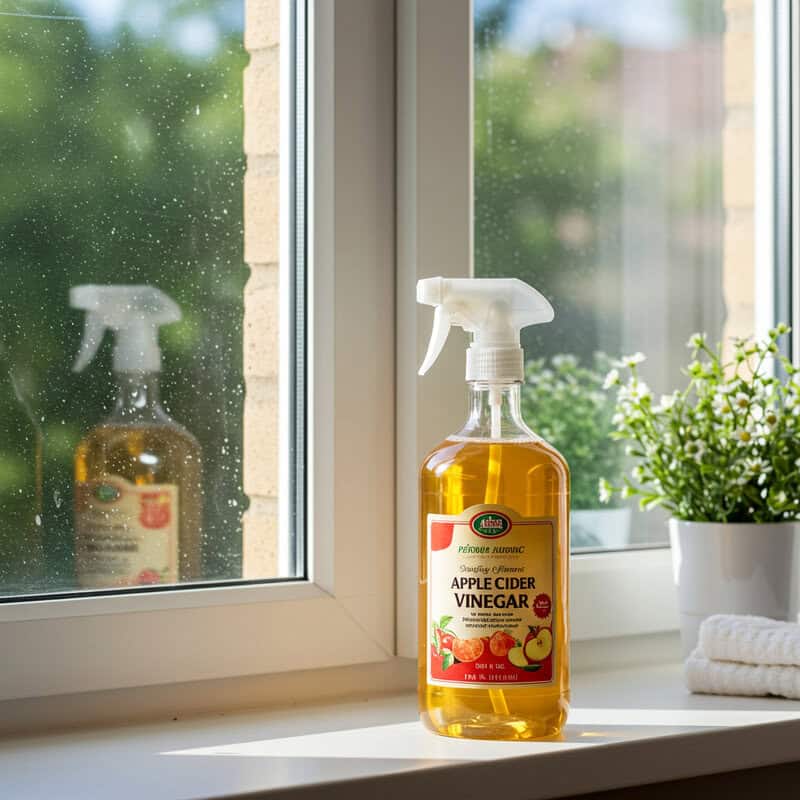
Apple cider vinegar is an excellent alternative to commercial window cleaning products, thanks to its natural streak-free cleaning abilities. The acetic acid in ACV effectively dissolves dirt, grime, and mineral deposits that can cloud glass, leaving windows bright and clear. Unlike ammonia-based cleaners, which often emit strong fumes and may pose respiratory hazards, ACV is non-toxic and safe for use around children and pets (Good Housekeeping).
To create a simple window cleaning solution, mix equal parts apple cider vinegar and water in a spray bottle. For extra cleaning power, add a few drops of liquid dish soap to cut through greasy residues. Spray the solution directly onto the glass, then wipe clean with a microfiber cloth or crumpled newspaper for a streak-free shine. This method not only eliminates fingerprints and smudges but also helps repel dust buildup. Avoid using ACV on tinted or specialty-coated glass without checking manufacturer recommendations. For more eco-friendly cleaning ideas and guidance on safe alternatives to chemical cleaners, visit the EPA Safer Choice products page.
21. Fabric Softener Substitute

Apple cider vinegar is a popular natural alternative to commercial fabric softeners, offering a gentle way to soften fabrics and reduce detergent residue in laundry. The acetic acid in ACV helps break down mineral and soap buildup on clothing fibers, leaving garments feeling softer and fresher without the use of synthetic fragrances or chemicals commonly found in commercial softeners (Healthline). Additionally, using ACV can help prevent static cling and is suitable for those with sensitive skin or allergies to standard laundry products.
To use ACV as a fabric softener, simply add half a cup of apple cider vinegar to the rinse cycle of your washing machine. It will not leave a lingering vinegar smell, as the scent dissipates during drying. Unlike commercial softeners, ACV does not coat fabrics with chemicals, allowing towels and activewear to retain their absorbency and breathability. For best results, avoid using vinegar on delicate fabrics like silk or on items labeled “dry clean only.” For more laundry tips and information about safe, eco-friendly cleaning, see advice from the EPA Safer Choice program.
22. Removing Pet Odors

Apple cider vinegar is an effective natural deodorizer for eliminating pet odors from bedding, carpets, and other soft surfaces. Its acetic acid content neutralizes odor-causing compounds, helping to freshen areas frequented by pets. While enzyme cleaners are often favored for their ability to break down organic stains and odors at a molecular level—especially for urine—ACV offers a simple, non-toxic alternative for general deodorizing and routine cleaning (PetMD).
To use ACV for pet odor removal, dilute one part apple cider vinegar with two parts water in a spray bottle. Lightly mist pet bedding, crates, or soft furnishings, and allow the area to air dry. For machine-washable items, add half a cup of ACV to the wash cycle to help neutralize persistent smells. Always test a small, inconspicuous area first to ensure colorfastness and fabric compatibility. Avoid spraying directly on pets or using near their eyes and mucous membranes, as the acidity may cause irritation. For severe or set-in stains, enzyme cleaners may be more effective. For more tips on pet-safe cleaning methods, visit the ASPCA.
23. Weed Killer
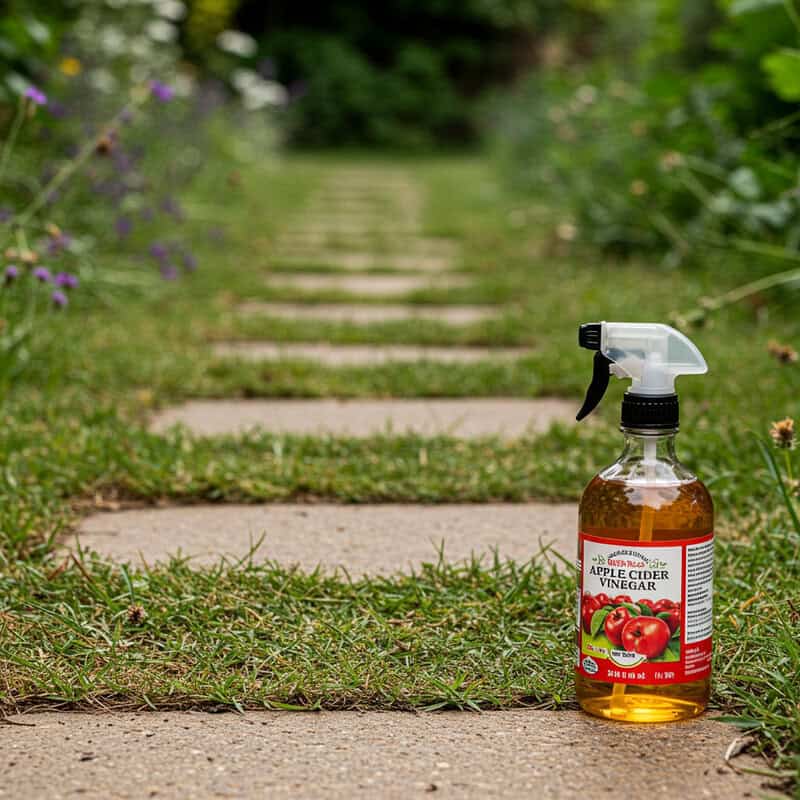
Apple cider vinegar’s high acetic acid content makes it a potent natural weed killer for driveways, sidewalks, and garden paths. The acid disrupts plant cell membranes, causing dehydration and rapid wilting of unwanted weeds (Gardening Know How). While chemical herbicides target weeds systemically—often reaching roots and providing longer-lasting control—ACV-based solutions are best suited for spot treatment, especially on young or annual weeds. They are biodegradable and less toxic, making them a preferred choice for eco-conscious gardeners.
To create a homemade weed killer, combine one quart of apple cider vinegar with two tablespoons of salt and one teaspoon of liquid dish soap in a spray bottle. Shake well and apply directly to the leaves of weeds on a dry, sunny day. The soap helps the solution adhere to foliage, enhancing effectiveness. Take care to avoid desirable plants, as ACV is non-selective and will damage or kill any vegetation it contacts. For large or persistent weed problems, repeated treatments or manual removal may be necessary. Always use caution and wear gloves when handling vinegar solutions outdoors. For more guidance on safe weed control, see the U.S. EPA.
24. Dishwasher Rinse Aid
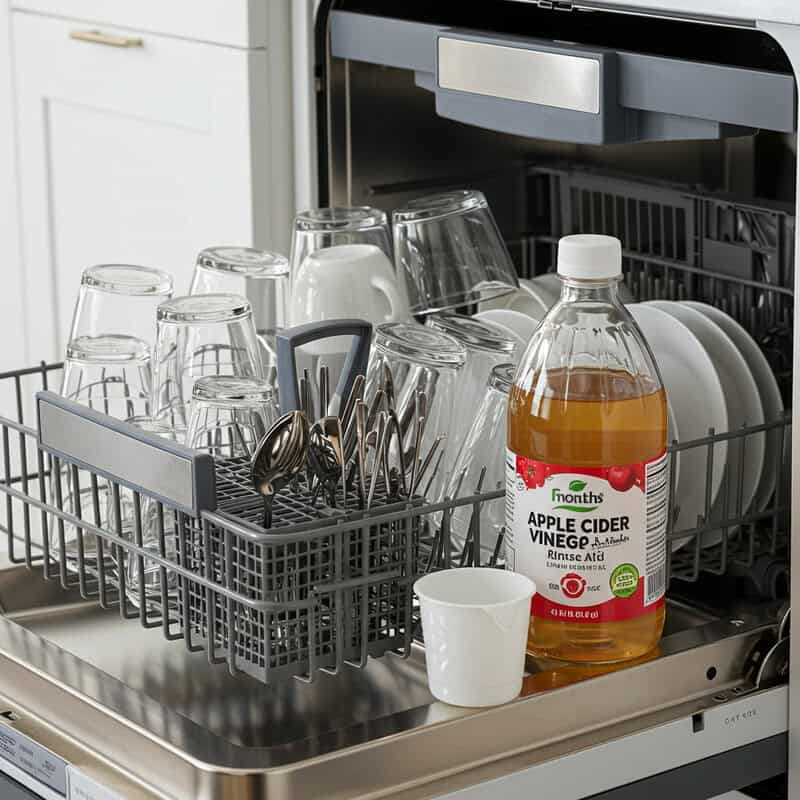
Apple cider vinegar can serve as an effective and natural rinse aid in dishwashers, helping to prevent water spots and residue on glassware and dishes. The acetic acid in ACV breaks down mineral deposits left behind by hard water, resulting in clearer, shinier surfaces after each wash. While commercial rinse aids often contain surfactants, fragrances, and other chemicals to achieve similar effects, ACV offers a non-toxic and environmentally friendly alternative (Good Housekeeping).
To use ACV as a dishwasher rinse aid, fill the machine’s rinse aid compartment with apple cider vinegar, or place a small cup of ACV upright in the top rack before starting the wash cycle. Avoid pouring vinegar directly onto metal components, as prolonged exposure to strong acids may cause corrosion over time. ACV is especially effective for homes with hard water, but if stubborn spots persist, consider increasing the vinegar concentration slightly. Always check the dishwasher manufacturer’s recommendations before using any alternative rinse aids to ensure compatibility and maintain the appliance warranty. For more tips on eco-friendly dishwashing, visit the EPA Safer Choice products resource.
25. Relieving Heartburn

Apple cider vinegar is sometimes used as a home remedy for heartburn, based on the theory that certain cases of acid reflux are caused by low stomach acid rather than excess acid. The idea is that ACV may help increase stomach acidity, supporting better digestion and potentially reducing symptoms of reflux in some individuals (Healthline). This approach stands in contrast to antacids, which work by neutralizing stomach acid to provide quick relief from heartburn, especially when caused by high acidity.
To try ACV for mild heartburn, dilute one teaspoon to one tablespoon of apple cider vinegar in a large glass of water and sip slowly during or after a meal. However, evidence supporting the efficacy of ACV for heartburn is largely anecdotal, and the remedy is not suitable for everyone—especially those with ulcers, severe acid reflux, or esophageal irritation, as the acidity can worsen symptoms. It is crucial to consult a healthcare provider before using ACV to manage heartburn, particularly if symptoms are frequent or severe. For more evidence-based strategies for managing acid reflux and when to seek medical advice, refer to the American Gastroenterological Association.
26. Freshening Laundry
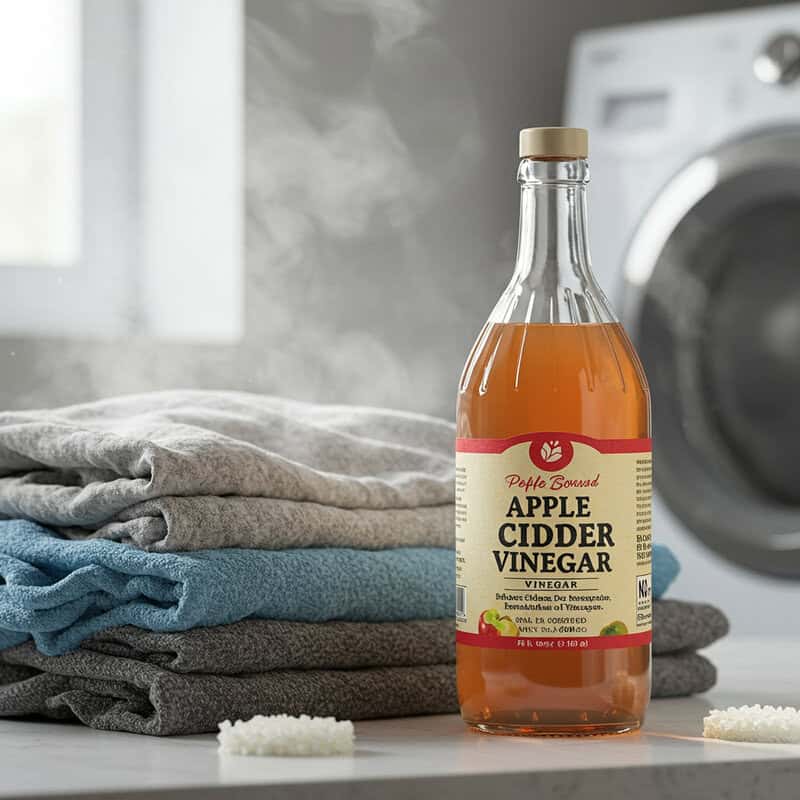
Apple cider vinegar is a powerful natural deodorizer for laundry, effectively neutralizing stubborn odors in fabrics rather than merely masking them with fragrances. The acetic acid in ACV breaks down odor-causing compounds and residues left by sweat, mildew, or food, resulting in fresher-smelling clothes and linens. Unlike conventional scented laundry products, which may use artificial fragrances to cover up smells, ACV addresses the source of the odor and is suitable for those with fragrance sensitivities or allergies (Healthline).
To freshen laundry, add half a cup of apple cider vinegar to the washing machine during the rinse cycle. This will help eliminate lingering odors and leave fabrics soft and residue-free. For extra-tough smells, such as from gym clothes or pet bedding, soak items in a solution of one part ACV to four parts water for 30 minutes before washing. The vinegar scent dissipates during drying, leaving only clean results. Avoid using ACV on delicate fabrics or garments labeled “dry clean only.” For more eco-friendly laundry practices and tips on odor control, visit the EPA Safer Choice page.
27. Removing Warts
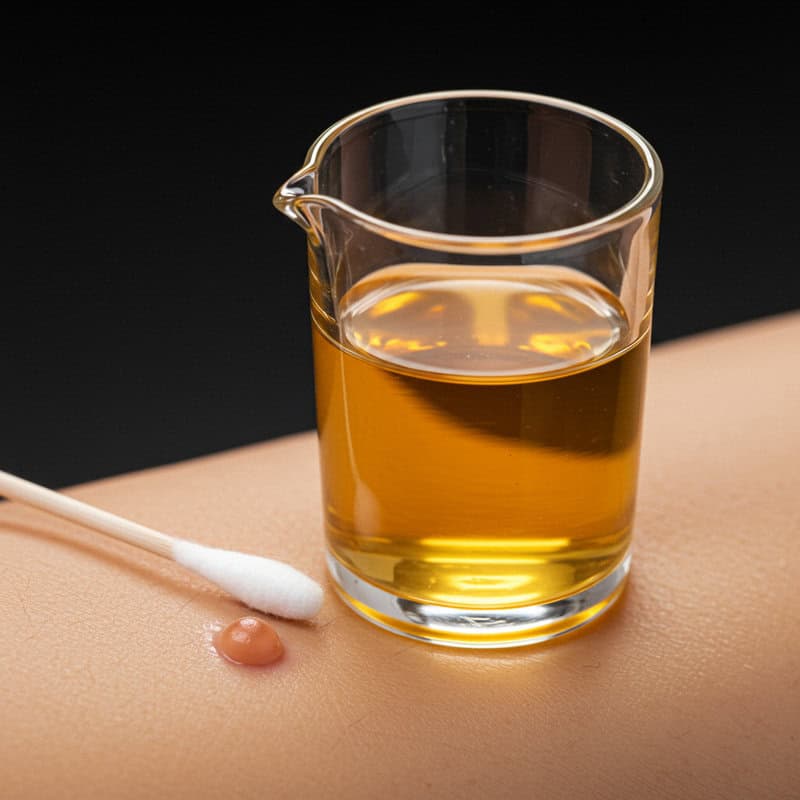
Apple cider vinegar is a popular home remedy for removing common warts, which are benign skin growths caused by certain strains of the human papillomavirus (HPV). The acetic acid in ACV is thought to work by gradually breaking down the tissue of the wart, similar to how some over-the-counter solutions use salicylic acid to exfoliate and destroy wart cells (Healthline). While some anecdotal evidence supports this approach, scientific research on ACV’s effectiveness for wart removal is limited, and it may not be as reliable or fast-acting as medical treatments.
To try this method, soak a small piece of cotton in apple cider vinegar, apply it to the wart, and secure it with a bandage. Leave it on for several hours or overnight, then remove and rinse the area. This process can be repeated daily for several days or until the wart darkens and falls off. However, ACV can cause skin irritation, burns, or pain, especially if used on sensitive areas or for extended periods. Never use this method on genital warts or facial warts, and consult a healthcare provider for persistent, painful, or unusual skin growths. For more information on safe wart removal, visit the American Academy of Dermatology.
28. Relieving Cold Symptoms

Apple cider vinegar is often used in traditional home remedies for managing mild cold symptoms, such as nasal congestion and sore throat. Its acetic acid content may help thin mucus, while its mild antibacterial properties offer some comfort for irritated throats. Many people combine ACV with honey and warm water to create a soothing drink, which is similar to other popular remedies like honey-lemon tea or saline nasal rinses (Healthline). While there is limited scientific evidence supporting ACV’s ability to treat or shorten colds, its use as a warm beverage may provide temporary relief and promote hydration.
To prepare a honey-vinegar drink, mix one to two tablespoons of apple cider vinegar and one tablespoon of honey into a cup of warm (not hot) water. Sip slowly to soothe the throat and help ease congestion. This beverage can be enjoyed up to twice daily, but always use diluted ACV to avoid throat irritation and enamel erosion. Individuals with underlying health concerns, allergies, or who are taking medications should consult a healthcare provider before trying new remedies. For more information on safe and effective cold relief, visit the Centers for Disease Control and Prevention (CDC).
Conclusion

Apple cider vinegar’s remarkable versatility spans practical household tasks and a wide array of health-related uses, from natural cleaning and food preservation to potential digestive and skin benefits. While its popularity is supported by centuries of tradition, it’s crucial to differentiate between anecdotal claims and evidence-based practices. Not all purported benefits have strong scientific backing, and some applications may carry risks if misused. Before incorporating ACV into your daily routine or home remedies, consult reputable sources such as the Mayo Clinic or speak with a healthcare professional. This mindful approach ensures you can safely enjoy the many surprising uses of apple cider vinegar.
Disclaimer
The information provided in this article is for general informational purposes only. While we strive to keep the information up-to-date and correct, we make no representations or warranties of any kind, express or implied, about the completeness, accuracy, reliability, suitability, or availability with respect to the article or the information, products, services, or related graphics contained in the article for any purpose. Any reliance you place on such information is therefore strictly at your own risk.
In no event will we be liable for any loss or damage including without limitation, indirect or consequential loss or damage, or any loss or damage whatsoever arising from loss of data or profits arising out of, or in connection with, the use of this article.
Through this article you are able to link to other websites which are not under our control. We have no control over the nature, content, and availability of those sites. The inclusion of any links does not necessarily imply a recommendation or endorse the views expressed within them.
Every effort is made to keep the article up and running smoothly. However, we take no responsibility for, and will not be liable for, the article being temporarily unavailable due to technical issues beyond our control.




